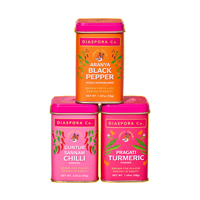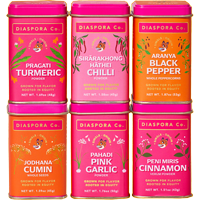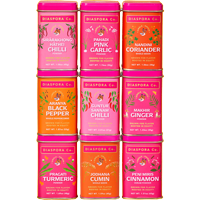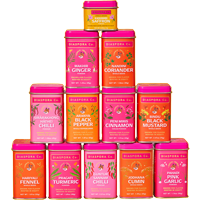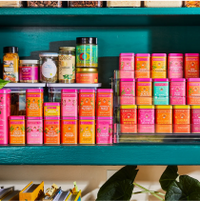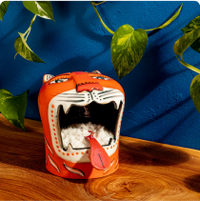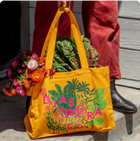It’s 10.15 on a Wednesday morning, and I’m watching a baby Russel’s viper slowly make its way across a forest path. Its skin is richly patterned with brown, black, and beige, and it moves with exquisite grace, gliding past fat blades of Bermuda grass, little stones and delicate ferns, and finally, into a rocky crevice a few feet away. I marvel at its beauty, give silent thanks to the habitat that supports this rare reptile, and make a mental note to watch where I put my feet.
The viper is one of several creatures I encounter that day, while walking with my friend Jivan Jenkins, through his family’s food forest in the Palani Hills of Tamil Nadu, in south India. The Palani Hills are part of the Western Ghats, a biodiversity hotspot that dates back several millennia and thrums with life, from towering ficus trees to tiny, rare orchids no larger than a fingernail.
Today, we’re looking for turmeric plants, but there’s so much to soak in along the way. We stop to examine the bark of the sambrani tree for perfumed, crystallised resin locally used as frankincense. To collect ripe avocados that have fallen to the ground. To harvest velvety wood-ear mushrooms blooming on a hunk of decomposing jackfruit wood.
At some point, I realise the ground is dotted with turmeric plants, shimmying in the morning sunshine. I recognise the leaves from the plants in my own vegetable garden: smooth, flat, and vivid green, like the plumage of parakeets. Here, they grow in clusters, nestled between trees of avocado, guava, pink cedarwood, sitaphal, and other native species. “Are these wild?” I ask Jivan. “Kinda,” he responds, with a gummy smile. “We planted a few kilos of turmeric some years ago, and now, it’s pretty much everywhere.”
As I examine the leaves, I think about the space turmeric occupies in my own life. I use the powder every single day in the kitchen: in dal, stir fries, meat marinades, and herbal remedies for itchy throats and clogged sinuses. When leeches bite the gaps between my toes, as they often do in the monsoon, I dab on some turmeric to keep infection at bay. When a pimple rears its whitehead, I smear my face with a mixture of turmeric, rose water, and honey. When red ants mount invasions into my kitchen, I line the windows with turmeric powder. It is flavour, it is medicine. It is the closest thing to panacea that I know.
![]()
Turmeric powder is made from the rhizomes of a species called Curcuma longa, which is one of several varieties of turmeric that grow across South Asia and the Asia-Pacific region. From a book called Turmeric: The Genus Curcuma, by P.N. Ravindran, I learned that there are over 100 types of turmeric, ranging from pale white to grey-black.
There is Curcuma amada, colloquially called mango turmeric, which has the delicate scent of green mango; Curcuma aromatica, or wild turmeric that is used mostly for cosmetic purposes; and Curcuma caesia, native of the northeast of India that has blue-grey flesh, like a fresh bruise. All varieties have been used in native medicine for centuries, if not longer.
The most popular however, is undoubtedly Curcuma longa, which yields the bright yellow powder popularly used in Indian cuisine and American golden lattes. Longa is prized for its high levels of curcumin – a chemical that is famed for its anti-inflammatory properties – and India is its largest producer, consumer, and exporter.
India’s relationship with turmeric has many layers. In Hindu temples, it is offered to deities and the devout in the form of a vivid red powder called kumkum, which is a combination of turmeric and slaked lime. In traditional medicine systems, such as Unani, Sidha, and Ayurveda, turmeric is ingested and applied topically for its healing properties. There are countless examples of indigenous communities using turmeric in sacred ritual, as well as for medicine.
And here we are, thousands of years later, still dabbing turmeric on cuts and bites, and drinking turmeric tea to treat a wide array of ailments from viral flu to leech bites.
“In some communities, the association with turmeric starts with birth,” reports Ravindran. “In such cases, the newborn is given a mixture of turmeric and coconut milk (yellow milk) as the first intake.” Manjal, as turmeric is called in Tamil, is also an important part of Hindu, Muslim, and indigenous tribal wedding rituals in many parts of India.
In parts of Tamil Nadu, both bride and groom are smeared with a mix of turmeric and sesame oil, then bathed in turmeric water in the days preceding the nuptials. The marriage is considered sacrosanct when “the bridegroom ties a thread around the bride’s wrist, to which is attached a piece of turmeric and betel nut,” writes Ravindran. Afterwards, the home of the newly wedded couple is smeared with turmeric and kumkum.
Interestingly, the spice is also present in funerary settings. “In Tamil Nadu, application of turmeric over a dead body is a custom, and is intended for cleansing,” informs Turmeric: The Genus Curcuma, thus bringing its presence full circle.
![]()
My own associations with turmeric have changed over the years. When I lived in Bombay, I would purchase bottles of haldi (turmeric in Hindi) pickle from Gujarati grocery stores in my neighbourhood to savour with meals of dal, rice, and fried fish. In Goa, where my family lives, my mother would harvest turmeric leaves to make ela ada: A Keralite snack of rice-flour parcels stuffed with grated coconut, jaggery, and lots of cardamom, steamed in turmeric leaves. The stuffing can be sweet or savoury, and ranges from jackfruit jam to seafood and meat.
I now live in the Palani Hills of Tamil Nadu, where I have a vegetable garden with two kinds of turmeric, both of which I use fresh. There is mango turmeric that I add to chutneys and salad, and the yellow Curcuma longa that I use to make Indonesian-style rendang, Thai yellow curry paste, and brined Gujarati-style pickles. I love the plant for its hardiness (most creatures are uninterested in eating turmeric, which is a treat for organic gardeners) and for the lushness of its leaves, which I often add to flower arrangements around the home.
![]()
Like many ingredients, the history of turmeric is both fascinating and murky. According to the second edition of Herbal Medicine: Biomolecular and Clinical Aspects, by Sahdeo Prasad and Bharat B. Aggarwal, turmeric has been used in present-day India since eons. The book cites the example of “Susruta’s Ayurvedic Compendium, dating back to 250 BC, [that] recommends an ointment containing turmeric to relieve the effects of poisoned food.”
The authors of Turmeric: The Genus Curcuma concur on its use since “ancient times” but say “there is little evidence to indicate that C. longa is a native of India.” From a chapter outlining the rhizome’s history, I learn: “In all probability, it seems like the true turmeric (C.longa) came to India from the ancient regions of Cochin China (present-day Vietnam) or China, either through the movement of ancient tribal people during their migration to the northeast region of India, or through the Buddhist monks and ancient travellers who reached India during the post-Buddha era.” The book goes on to postulate that travellers might have been carrying turmeric “as a remedy for two of the most common ailments: wounds and stomach trouble.” And here we are, thousands of years later, still dabbing turmeric on cuts and bites, and drinking turmeric tea to treat a wide array of ailments from viral flu to leech bites.
![]()
The day after my visit to Jivan’s food forest, I meet Badri Narayanan R, an organic farmer who lives in the neighbourhood. His picturesque farm lies at the end of a 2.5 km-long mud path, and is dotted with trees and bordered by a stream on three sides. Through gaps in the tree canopy, I see views of the Palani Hills, a patchwork of forest, grassland, and exposed rock. In the background, the stream gurgles, like a zen meditation track.
“Growing food is not an easy life,” Badri says, “Truthfully, I barely make any money, but working with my hands, with the soil, with the land, this is a priceless luxury.”
Badri’s primary crop is turmeric, and he uses more intensive growing techniques to maximise his yield. The land is tilled, neat rows of raised mounds are created, and the rhizomes are planted just before the monsoon, so the water-loving plants have plenty to drink. According to Badri, water is the most important element for growing turmeric. “The more, the better,” he says, pointing out a sprinkler system, which he uses to ensure that the soil remains moist.
When I visit in early July, the turmeric is about a foot tall, but the plants will grow as tall as a metre, creating a swathe of dense, vibrant green. By March next year, the rhizomes will be ready. That’s ten months from seed to harvest – more than the gestation period of a human child.
From Badri, I learn that ten kilos of fresh turmeric yield about 1 kg of powder. The process is pretty laborious too: First the turmeric is harvested by hand. Then, it is steam-boiled in large vessels on a wood fire to prevent sprouting, and dried until it no longer contains water. Following this, the shrivelled rhizomes are polished (the process of removing the skin so the natural colour shines through), and finally, powdered and packed. Under proper conditions, the shelf life of turmeric is over five years.
Snapping open a finger of fresh turmeric, Badri points to the ring of colour in the centre of the rhizome: a deep, marigold-yellow compared to the slightly paler colour outside the ring. “This ring contains the curcumin,” he explains. “But nowadays, most organic growers extract the curcumin for international markets, and then use what’s left to make powder for local buyers. For vibrance, artificial colour is added. So many people religiously consume turmeric for its beneficial properties, but what are they really adding to their food and their bodies?”
Badri grows Pragati Turmeric, a varietal that is valued for its high curcumin content. But as he is quick to point out, the quality of any crop is directly related to the vitality of the habitat in which it is grown, and the care with which the plants are nurtured. “In Tamil, we have a saying that goes ‘Mūchu k kaṟṟu, chedile padano’, which roughly translated means: ‘The breath of the farmer should be felt on the plants,” he says. It is an eloquent reminder that growing food is a collaborative process, between plants, humans, and the countless organisms that share our habitat with us.
In Badri’s case, this includes the bugs and worms that live in the soil, the birds and squirrels that nest in the trees around, and the occasional wild boar that digs up the turmeric looking for worms to snack on. “The Excel Sheet-model does not work for organic farming,” he says, “as there are just too many variables.” If it rains, the output is different. If an elephant visits, the output is different. If a neighbouring farmer decides to spray his field with pesticides, the output is different. “Growing food is not an easy life,” Badri says, “Truthfully, I barely make any money, but working with my hands, with the soil, with the land, this is a priceless luxury.”
Curious to see what the turmeric in my own garden looks like, I empty a grow bag in which I had planted some rhizomes at the start of the pandemic. With the help of my partner Vahishta and friend Vinay, I carefully peel away the grow bag until the root system is exposed, and I can see the rhizomes, like knobby fingers.
In addition to the yellow Curcuma longa – now as familiar as a close friend – I unearth a mass of delicate mango turmeric, nestled together, in one very crowded growbag. With a song in my heart, and the pungent smell of curcuma on my fingertips, I consider going through the process that Badri outlined: steam-boil, dry, then polish, and finally, grind to a powder, but truth be told, I am curious to experiment with the leaves.
So I pick four of the largest ones, clean them, and quickly pass the leaves over a naked flame to make them more pliable. I have two fillings for my ela ada today: a classic combination of fresh coconut, jaggery, and cardamom; and a savoury version of shredded chicken in a rich masala of onions, tomatoes, black pepper, coriander and turmeric powder.
Using my fingers, I spread the rice-flour dough over the oiled leaves, one at a time, and as thin as possible. The fillings are layered on, and finally, the leaves are folded in half, sealing the stuffing inside. I place the parcels in a steamer, and within seconds, the room is heady with the green, grassy aroma of turmeric leaves.
The use of other spices may vary from region to region, but the presence of turmeric in the Indian spice box is ubiquitous and sacrosanct.
It is visceral, bringing with it visions of forest canopy, the frilly, grey lichen on tree trunks, the springy feel of forest litter underfoot: dark, loamy, and fragrant with the stuff of life. This, here, is what I love about food: it is the point of connection between our habitat and our bodies. To eat is to bring the outside within, to nourish our bodies, but also potentially, to nourish our mind, heart, and spirit.
Minutes later, the ela adas are ready.
I unwrap a leaf parcel, dunk a piece into a puddle of warm ghee, and think about how turmeric is used across kitchens in India, from the Himalayan reaches of Kashmir to the coastline of southern Kerala. The use of other spices may vary from region to region, but the presence of turmeric in the Indian spice box is ubiquitous and sacrosanct. It is flavour, medicine, cosmetic and preservative, a quiet witness to births, adolescence, matrimony, and ultimately, our body’s return to the earth.
As far as spices go, that arc is a remarkable one.







